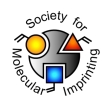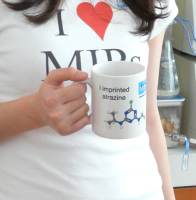
Authors: Joshi S, Rao A, Lehmler HJ, Knutson BL, Rankin SE
Article Title: Interfacial molecular imprinting of Stöber particle surfaces: A simple approach to targeted saccharide adsorption.
Publication date: 2014
Journal: Journal of Colloid and Interface Science
Volume: 428
Page numbers: 101-110.
DOI: 10.1016/j.jcis.2014.04.041
Alternative URL: http://www.sciencedirect.com/science/article/pii/S0021979714002604
Abstract: The use of surfactant headgroups for interfacial imprinting is established as a simple and tunable approach to create molecularly imprinted silica nanoparticles based on a modification of the Stöber method. Adsorption of d-glucose and d-xylose (initial concentrations ranging from 0.139 to 1.67 mol/l) is measured on silica nanoparticles created by the addition of a glucose-based surfactant (n-octyl-β-d-glucopyranoside (C8G1)) or surfactant mixtures (C8G1 and cetyltrimethylammonium bromide (CTAB)) to Stöber particles shortly after their precipitation. Silica particles synthesized in the presence of C8G1 as an imprinting surfactant have a significantly higher affinity for glucose over xylose (as much as 3.25 times greater at 0.25 M saccharide), and an enhanced affinity for glucose relative to non-imprinted silica particles (as much as 4 times greater at 0.25 M), which adsorb glucose and xylose similarly. Glucose imprinting is significantly enhanced using a surfactant mixture of 1:1 C8G1/CTAB. The interfacial activity of the nonionic imprinting surfactant at the silica surface is suggested to be improved by the presence of interfacial cationic CTAB, which is driven to the silica surface through electrostatic interactions. The concept of imprinting through the interaction of surfactant headgroups with the soft surface of silica particles is supported by the importance of the time of addition of the surfactants. The greatest enhancement in glucose adsorption is observed when the surfactants are added 1 min after precursor addition (at the onset of aggregated particle formation, as indicated by solution turbidity) and the silica affinity for glucose decreases with the time of surfactant addition. The versatility of the surfactant imprinting of Stöber particles is demonstrated by the enhanced adsorption of xylose relative to glucose on particles imprinted using a 1:1 mixture of n-octyl-β-d-xylopyranoside and CTAB, suggesting that the process can be customized to selectively adsorb target molecules of interest
Template and target information: monosaccharides, n-octyl-β-d-glucopyranoside, C8G1, glucose, n-octyl-β-d-xylopyranoside, xylose
Author keywords: nanoparticles, separations, Glycobiology, molecular imprinting, adsorption



Join the Society for Molecular Imprinting

New items RSS feed
Sign-up for e-mail updates:
Choose between receiving an occasional newsletter or more frequent e-mail alerts.
Click here to go to the sign-up page.
Is your name elemental or peptidic? Enter your name and find out by clicking either of the buttons below!
Other products you may like:
 MIPdatabase
MIPdatabase









